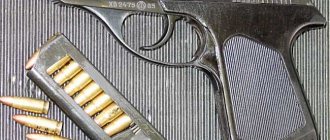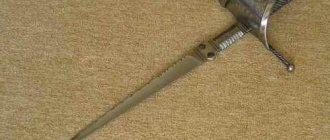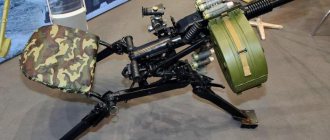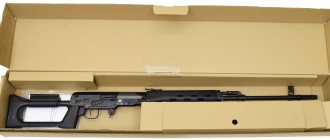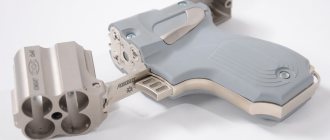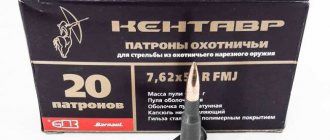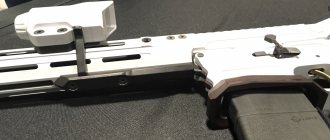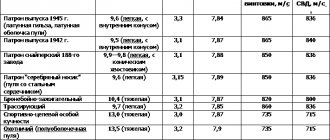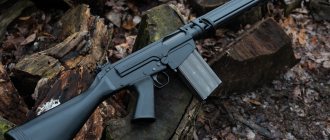| 7.62×51mm NATO | |
| |
| Cartridge type: | rifle |
| Manufacturer country: | USA USA |
| Type of weapon using cartridge: | automatic rifles, sniper rifles, machine guns |
| Service history: | |
| Used: | NATO |
| Wars and conflicts: | Vietnam War, Gulf War, Afghanistan War, Iraq War |
| Production history: | |
| Time of creation: | 1947[1] |
| Characteristics: | |
| Chuck length, : | 69,85 |
| Current bullet caliber: | 7,85[1] |
| Bullet weight: | 10.2[1] 7.8—13.6 (.308 Win)[1] |
| Sleeve shape: | bottle without protruding flange[1] |
| Sleeve length: | 51,18 |
| Case neck diameter, : | 8,77 |
| Case shoulder diameter, : | 11,53 |
| Sleeve base diameter, : | 11,94 |
| Sleeve flange diameter, : | 12,01 |
| Powder charge mass, : | 3.1[1] 2.38—3.06 (.308 Win)[1] |
| Initial bullet speed, m/s: | 840[1] 671—976 (.308 Win)[1] |
| Bullet energy: | 3600[1] 3061—3715 (.308 Win)[1] |
| Images on Wikimedia Commons: | 7.62×51mm NATO |
7.62x51 mm NATO
(official designation
7.62 NATO
) is the standard rifle and machine gun ammunition of NATO member countries.
Adopted in 1954 under the designation T65
, subsequently modernized several times.
Development
This cartridge was developed after World War II as a lightweight version of the obsolete .30-06 (7.62×63 mm), with the expectation of achieving the same ballistics and energy of the ammunition while reducing its size due to the smaller mass of the charge of more powerful and modern gunpowder in reduced sleeve.
As a result of American political pressure, this cartridge was adopted by NATO member countries, even those that at that time had their own rifle and machine gun cartridges, for example, British 7.7x56 mm R, Italian 6.5x52 mm, French 7.5x54 mm or German 7.92x57 mm. However, experience in combat use showed its power to be excessive for an automatic weapon, so it was subsequently supplanted by the low-pulse 5.56x45 mm cartridge. Currently widely used in machine guns, snipers and civilian weapons.[1]
The cartridge uses all bullets approved for military use - regular, tracer, armor-piercing and others. The sleeve is usually made of brass, but sometimes steel is used.[1]
The characteristics roughly correspond to Russian 7.62×54 mm R cartridges.
Our domestic main manufacturers of the 7.62x51 caliber cartridge, as it is officially called in Russia, and these are the Barnaul Machine Tool Plant, the Novosibirsk Low-Voltage Equipment Plant and the Tula Cartridge Plant, do not stand still and are actively responding to what is happening in the hunting weapons market. The range is noticeably growing and expanding, and the quality is improving. The best examples of domestic 7.62x51 caliber cartridges are not inferior to foreign manufacturers in terms of ballistic characteristics. Many hunters, owners of imported rifled weapons, successfully use our domestically produced cartridges while hunting, finding no qualitative difference in shooting. However, there is a difference – price. This is not surprising, but rather natural. For example, the Novosibirsk Cartridge Plant produced in a short period a line of 308 caliber cartridges (7.62x51), which many have already appreciated.
The editorial staff of the Hunter's Arsenal magazine managed to get to know them.
A bullet enclosed in a tombac casing does not spoil the rifling of barrels, and brass casings do not clog the chamber of a weapon, as happened with steel and varnished casings and steel bullet casings. Cartridges from the Novosibirsk Cartridge Plant, during a test shooting carried out by the magazine's editors in January-February of this year, confirmed the characteristics of combat accuracy, without exceeding the values specified by the plant. They were also tested on practical hunts - four times shooters went boar hunting with weapons loaded with Novosibirsk “Extra” cartridges of 7.62x51 caliber, and every time they had to shoot, the bullets landed exactly on the slaughter spot. Our shooters had no doubt about the good quality of the Novosibirsk “Extra” cartridges, as well as the “High Accuracy” and “Increased Accuracy” cartridges. However, the test is not over yet, and there is an intention to bring it to its logical conclusion. However, today it can be argued that all three cartridges have high combat accuracy, which not every imported cartridge can provide. An ordinary hunter traveling to the hunting grounds of the middle forest belt, where there are no large spaces not occupied by forests, rarely has to shoot at an animal from a distance of more than a hundred meters. For a shot when the animal is 50-80 meters away, the accuracy of Novosibirsk cartridges is extremely sufficient.
Today, the range of 308 Win (7.62x51) cartridges produced by Novosibirsk Cartridge Plant JSC includes the following versions: • 308 Win (7.62x51) hunting cartridges with a bimetallic sleeve and FMJ jacketed bullet (with a bimetallic/tompak jacket); • hunting cartridges 308 Win (7.62x51) with a brass sleeve and FMJ jacketed bullet (with a bimetallic/tompak jacket); • hunting cartridges 308 Win (7.62x51) with a bimetallic sleeve and SP jacketed bullet (with a bimetallic/tompak jacket); • hunting cartridges 308 Win (7.62x51) with a brass sleeve and an SP jacketed bullet (with a bimetallic/tompak jacket); • hunting cartridges 308 Win (7.62x51) with increased accuracy with a brass sleeve and an FMJ jacketed bullet with a tombak jacket; • hunting cartridges 308 Win (7.62x51) of high accuracy with a brass sleeve and FMJ jacketed bullet with a tombak jacket; • hunting cartridges 308 Win (7.62x51) “Extra” with a brass sleeve and an FMJ jacketed bullet with a tombak jacket.
A brass sleeve and a bimetallic sleeve cannot cause harm to a weapon; rather, a steel sleeve will do this; the friction coefficient of varnished sleeves is significantly lower than brass and bimetallic sleeves. Poor sealing of powder gases with steel sleeves reduces the service life of the barrel - the advantages of brass and bimetallic sleeves are obvious.
Cartridge designations 7.62×51 mm
The following designations for the 7.62×51 mm cartridge are found:[1]
- 7.62 mm Mle 54,
- 7.62 Model 1954,
- 7.62×51 NATO,
- 7.62 OTAN,
- .308 NATO,
- M59 - military cartridge with a steel core bullet,
- M61 - military cartridge with an armor-piercing bullet,
- M62 - military cartridge with a tracer bullet,
- M80 - military cartridge with a full metal jacket bullet,
- M118 - army sniper cartridge
- M198 - two-bullet cartridge,
- M993 - military cartridge with an armor-piercing bullet,
- M118LR - variant of the sniper cartridge,
- .308 Winchester
, .308 Win - commercial version, - XCR 08 051 BGC 060,
- 7.62×51 A - Soviet hunting cartridge with a semi-jacketed bullet
- 7.62×51M.308 Win is a modernized hunting cartridge.
Ammunition: Two from the casket are identical from the face (7.62) - Author Sergey Korobkov
The 7.62x51 cartridge was created as an analogue of the .308 Winchester and was recommended “for shooting medium and large animals.” It was assumed that it would eventually replace the well-used 7.62x53. Thirty years have passed, and the 7.62x54R (hunting version 7.62x53) is not even thinking about “retiring.” Foreign manufacturers still produce these hunting cartridges. New models of hunting weapons are being developed for it. So is it worth replacing one with the other? Let's try to figure it out. Ambiguous assessments of domestic cartridges arise in many cases due to too general recommendations for their use. It is often impossible to find comprehensive information defining the technical characteristics of a cartridge. The initial speed indicated by the manufacturer in practice determines little if there are no externally ballistic characteristics. High muzzle energy of a bullet is not the only parameter that determines the successful outcome of a hunt; it is important that the energy is retained over long distances and used to completely kill the animal.
This is achievable only with an optimal combination of mass, initial speed, aerodynamic and design parameters of the bullet, the cartridge as a whole and the technical characteristics of the weapon from which this cartridge is fired. One can confidently speak about the lethality of a cartridge only when considering the “cartridge-weapon” rifle complex. Shots of identical cartridges from guns with different barrel lengths will produce different muzzle velocities. Therefore, we will talk about the characteristics of cartridges, and even more so compare them with each other, only in relation to the specific weapon from which the shooting is carried out.
Not counting the few examples of combined fittings, we list the main types of domestic hunting rifles chambered for 7.62x54R. These are: self-loading carbines of the Tiger series (barrel length 620 mm), Berkut-2M (620 mm). We do not accept the KO-44 carbine for consideration, since it is an obsolete system with a short barrel and, therefore, a low initial velocity for this type of cartridge. There are more types of domestic hunting weapons chambered for 7.62x51: self-loading carbines of the Vepr and Bear series, carbines of the Elk and Maral series. Most of them have a barrel length of 550 mm.
The ballistic characteristics of the 7.62x51 cartridge with a light 9.7 gram bullet in relation to the Los carbine (550 mm barrel) and the 7.62x54R cartridge with a heavy 13 gram bullet in relation to the Tiger carbine (620 mm barrel) are shown in the table Fig. 1. A light bullet accelerates quickly in the barrel, and its initial speed is on average 120 m/s greater than that of a heavy bullet. The lower initial velocity of a heavy bullet, in turn, is compensated by its larger mass, and as a result, the values of muzzle energies (E = mv2/2) for 13-gram and 9.7-gram bullets are the same. A heavy bullet has greater inertia and retains speed and kinetic energy longer. On the contrary, a lighter bullet with less inertia loses speed faster due to air resistance. Its kinetic energy decreases faster (Fig. 3). Hunting for small animals that are weak to wounds does not place serious demands on the bullet. And at 500 meters the energy is enough to kill animals up to 100 kg. Cartridges with a full metal jacket (FMJ type) are the most versatile for such hunts and, presumably, are applicable at all reasonable distances. If both cartridges under discussion are loaded with FMJ type bullets, then their properties are identical and there are no differences in recommendations for their use. The energy of the 7.62x54R cartridge is greater than the energy of the 7.62x51 cartridge, but in practice this difference will not be noticeable, since due to poor visibility, the short duration of the target appearance and simply from an excess of feelings, it will not be possible to accurately (and some hunters even approximately) determine the size and weight animal, distance to it. This allows us to say that, in terms of energy characteristics, cartridges 7.62x51 and 7.62x54R belong to the same group. The effectiveness of the shot will depend only on the accuracy of the shooter. Large (over 200 kg) and wound-resistant animals require a more careful choice of ammunition. High-energy cartridges with expansive SP bullets are appropriate here. Expansiveness significantly increases the destructive power of a bullet. However, there is a limit to everything. When the speed decreases below a certain threshold (let's call it the “speed of loss of expansiveness” and denote Vexp), the bullet loses its expansive properties. Let us denote the distance at which this occurs as Lexp. Beyond this distance, the energy is still high, but the bullet itself will no longer noticeably deform when it hits the target, and its properties will approach those of full-shell bullets. Wounds in large animals will not be fatal, therefore, the likelihood of wounded animals should be expected to increase. This fact is quite widely known, but it is rarely possible to find the values of Vexp and Lexp for a specific type of cartridge, and cartridge manufacturers do not even mention it. The expansion of 7.62 mm bullets decreases significantly at speeds below 600 m/s. At what distances does this happen?
From the graphs (Fig. 2) it is clear that the speed of the 7.62x54R SP bullet becomes less than 600 m/s at a distance Lexp = 215 meters. The kinetic energy at this distance is still high (2,340 J), and theoretically up to 400 meters it would be quite enough for an animal weighing 150 kg. But beyond 215 meters, the effectiveness of a bullet that has lost its expansion decreases several times, and wounded wounds are guaranteed. The 7.62x51 SP cartridge was slightly superior to its older brother. It becomes ineffective only 20 meters further, and in terms of energy conservation at long distances it loses to the 7.62x54R cartridge with the SP bullet. The only way to increase the effective firing range of cartridges with SP bullets is to increase the muzzle velocity. This will not only significantly increase shooting distances without losing the bullet's expansion, but will also increase its energy.
Well, the conclusions suggest themselves: • 7.62x54R SP and 7.62x51 SP cartridges are recommended for shooting animals weighing no more than 300 kg, and then only at a distance of no more than 70-100 meters. • At 200 meters you can reliably hit an animal weighing 200 kg, maximum 250 kg. • When firing cartridges with SP type bullets beyond 200 meters, the likelihood of wounded wounds increases significantly due to loss of expansion. • At distances beyond 250 meters, the differences between SP and FMJ bullets become blurred. • The popular belief that it is possible to kill an elk from a Tiger within half a kilometer has no basis. After 200 meters, the ballistic characteristics of the cartridges under discussion become similar to the characteristics of the 7.62x39 cartridge, and no one doubts the weakness of the latter (see “7.62x39: characteristics and prospects” - “MR” No. 62 2002). • In terms of energy indicators, the 7.62x54R SP cartridge is more powerful. This becomes especially noticeable at long distances, where it retains its energy longer than the 7.62x51 SP. When shooting at a small animal further than 250 meters, this difference, depending on the hunting conditions, can play some positive role.
The possibility of hitting an animal at distances over 300 meters requires a close analysis of the bullet’s flight path. In hunting areas, when there is no time to determine the distance to the target and rearrange the sight, it is advisable to have a weapon aimed at a specific animal. Usually, when discussing the issue of universal zeroing of 7.62 mm carbines, two cases are considered. For shooting at a small (up to 100 kg) animal with a probability of hitting a circle with a diameter of 20 cm and at a large one (more than 150 kg) with a probability of hitting a circle with a diameter of 40 cm. When shooting at large animals with cartridges with SP type bullets, the distance of reliable destruction is limited by the Lexp value = 200-250 m. From this limitation, as well as from the analysis of bullet trajectories (Fig. 4), it follows that zeroing the weapon and constantly setting the sight at 200 meters should guarantee a hit, both in the average elk and wild boar, and in the roe deer or wolf at any distance less than 230 meters. The hunter will only have to decide: the target is further than 230 meters or closer. Well, train your eye.
Despite the fact that the 7.62x51 and 7.62x54R cartridges retain significant energy at 500 meters, shooting at wild boars from a half-kilometer distance, even with the most powerful optics, seems like a crazy task. The trajectory of bullets overlaps the target only in a 40-meter zone. Accordingly, you will have to determine the distance with an accuracy of up to 20 meters, which can only be done when hunting “varminting”.
From all of the above, it follows that the choice of a hunting weapon chambered for domestic 7.62 mm caliber cartridges for hunting large game depends only on the personal sympathies of the hunter. Those who are “crazy” about the “military” style, who warm their souls with the possibility of almost automatic shooting and who have the strength to carry extra pounds in the forest, of course, do not want to hear about anything other than “Tiger”, and in their own way he is right . But it still seems that for those purchasing rifled weapons again, the 7.62x51 cartridge is more promising for two reasons. The first is that its counterpart is the .308 Win. is the most common 7.62 mm hunting cartridge in the world. In this context, we can expect our manufacturers to produce 7.62x51 cartridges with a large selection of bullets of different weights and designs. The second is the fact that our legislators are seeking to limit the circulation of weapons with cartridges similar to military ones, and if this happens, the Tigers will become the first victims.
Today's latest example from a series of military conversions chambered for the 7.62x54R cartridge is the proposed KO-91/30 carbine. Along with the shortcomings that came with the Mosin combat rifle (crowbar stock, integral magazine, lack of a safety lock), it also received one significant advantage. Namely, the barrel length is 745 mm. With such a barrel, you should expect an initial velocity of about 820 m/s for a 13-gram bullet. The muzzle energy will be in the region of 4,400 J, which will allow it to “swing” at animals weighing 350-400 kg up to 100 meters. The expansive properties of the bullet will remain up to 300 meters, which is enough for any hunt.
Ammunition comparison
| Cartridge | Bullet weight, | Bullet speed, m/s | Bullet energy |
| 5.56×45 mm | 3,95—5,18 | 772—945 | 1700—1830 |
| .30-06 | 9,7[2] | 856 | 3554 |
| 7.62×54 mm R[3] | 9.6 | 860 | 3550 |
| 7.62×51 mm | 9,33 | 838 | 3275 |
| 7.62×39 mm | 7,9 | 710—735[4][5] | 1991—2206[4][5] |
| 6.5×50 mm Arisaka | 9 | 770 | 2615 |
Benefits of 308 Caliber Hunting Weapon Systems
308 caliber hunting rifles can be multi-shot, automatic, semi-automatic, as well as single-shot and combined, with several barrels of different calibers. Self-loading and automatic carbines chambered for a shortened thirty caliber hit more accurately due to less recoil. The 308 caliber rifle for hunting has a number of other advantages. Single-shot carbines have a lighter bolt with a short stroke, which makes it possible to reduce the length and weight of the weapon without compromising shooting accuracy. The 308 caliber cartridge is universal. Under it you can find single-shot shotguns with both a horizontally sliding bolt and a vertically sliding one. 308-caliber bolt-action carbines are particularly compact, lightweight, and silently reload without delay, and they can have a shock spring in the form of a staple rather than a coil, making these systems trouble-free. There are also advantages that the 308 caliber has. Reviews from hunters indicate that if the magazine fails, these cartridges are easier to load into the chamber manually, one at a time, and with longer cartridges, such as caliber 30-06 and others, this technique is not as effective or not at all not possible due to length. And one more advantage. In repeating shotguns chambered for long cartridges, deformation of the soft shell of the bullet occurs much more often when it is automatically moved into the chamber, which affects the accuracy of the shot. Caliber 308 has much fewer complaints in this regard. Reviews from experts positively evaluate the 308 caliber in this regard, rather than the longer versions of the 30 caliber.
Weapons using cartridge
- ACR Magpul Massoud
- AR-10
- Beretta 501 sniper
- Beretta BM 59
- Blaser 93 LRS2
- Bor
- Browning M1917
- Browning M1919
- CM901
- CZ 700
- DSR-1
- DT SRS
- FN FAL
- FN MAG
- FN Minimi 7.62
- FN model D
- FN SCAR-H
- FN SPR
- FR-F1
- FR-F2
- Galatz
- GOL-Sniper
- HK121
- HK21
- HK417
- HK G3
- HK MSG90
- HK MSG-90A1
- HK PSG1
- HK SR9
- IMBEL .308 AGLC
- JNG 90 Bora
- L1A1
- L96A1
- M1 Garand
- M110 SASS
- M134 Minigun
- M14
- M21
- M24
- M25
- M240
- M39 EMR
- M40
- M60
- M73
- Mauser SP-66
- Mauser SR-93
- MCR 200
- MG-3
- Mk.14 EBR
- Mk.20 Mod.0
- Mk.48 Mod.0
- Mk.48 Mod.1
- MSR
- Parker-Hale M82
- Parker-Hale M85
- R11 RSASS
- Remington 700
- Sako TRG
- SIG-Sauer SSG 2000
- SIG-Sauer SSG 3000
- SIG SG 510
- SIG 716
- SIG SG 542
- SIG SG 751
- SIG MG 710-3
- SR-100
- SR-25
- SSG 04
- SSG 08
- SSG 69
- Steyr Scout
- TEI M89-SR
- Valmet M-78/83S
- VPR-308
- XCR-M
- SV-98
- T-5000
Notes
- ↑ 1234567891011121314
[weaponland.ru/board/patron_762x51_308_winchester/43-1-0-226 Cartridge 7.62×51 / .308 Winchester] (Russian). Retrieved April 7, 2013. [www.webcitation.org/6Fwzf0bC6 Archived from the original on April 17, 2013]. - with a light bullet
- with a light pointed bullet model 1930
- ↑ 12
Manual on small arms 7.62-mm Kalashnikov assault rifle (AK). 1958 - ↑ 12
Shooting manual. 7.62 mm Kalashnikov machine gun (RPK, RPKS). 1983
Links
Rifles and machine guns M1 and Mark 2 • M1918 • • M14 • M15 • M16 • XM22/E1 • XM106 • XM70 • FN SCAR • HK416/M27 Carbines M1/M2 • XM177/E1/E2 and GAU-5/A • Colt Model 653 • M231 • M4/A1/E2 • GUU-5/P • Mark 18 Sniper rifles M14SE • M21 • M24 • M25 • M39 • M40 • M82 and M107 • M88 and Mark 15 • M110 • Mark 11 • Mark 12 • Mark 14 • DMR • RC-50 • SAM-R • SDM-R • M2010 Submachine guns Thompson • • Smith & Wesson M76 • MP5/K Guns Ithaca M37 • Remington 870 • Mossberg 500/590 • M1014 • XM26 Machine guns M60 series and Mark 43 • XM207/E1 and Mark 23 • M73/M219 • M85 • M240 • Stoner 63 • M249 series and Mark 46 • XM262 • XM312 • Mk 21 • EX 27 • Mark 48 • Browning M2 • GAU-19 • M134 Minigun • LW50MG • LWMMG Hand grenade launchers M79 • XM148 • M203 • M234 • M320 • M32 • EX 41 • Mark 13 Automatic grenade launchers M75/M129 • XM174 • Mark 19 • Mark 47 • XM109 • XM307 Other weapons XM25 • M20A1/A1B1 • M67 • M72 series • M136 (AT4) • M141 • M202/A1 • Mark 153 • FIM-43 Redeye • FIM-92 Stinger • FGM-172 SRAW • Ammo 7.62x33mm • 5.56x45mm NATO • 7.62x51mm NATO • .30-06 Springfield • 12.7x99mm NATO • .300 Winchester Magnum • 9x19mm Parabellum • .45 ACP • 12 gauge Sniper rifles FR-F2 • FR-F1 • PGM Hecate II • PGM Ultima Ratio Slot machines FAMAS • SG 551 • HK416 Submachine guns HK MP5•P90 Machine guns Browning M2 • AA-52 • FN Minimi Guns Benelli M4 Super 90 Grenade launchers M203 • LRAC F1 • APILAS Mortars LLR 81mm • MO-120-RT61 mortar Missile weapons LRAC F1 • ABL • MILAN • ERYX • Mistral Ammo 12 gauge • 5.7×28 mm • 9×19 mm Parabellum • 5.56×45 mm NATO • 7.62×51 mm NATO • 12.7×99 mm NATO Submachine guns • XK9 •
XK10Machine guns and rifles M16A1 • • • XK8 • K11
Sniper rifles K14 Machine guns M60 • • • K12 Grenade launchers • K203 Guns USAS-12 Weapon cartridges 9×19 mm • 5.56×45 mm • 7.62×51 mm • 12.7×99 mm Italic experimental (not accepted for service) samples have been identified
The standard of accuracy - Remington 308 caliber
Hunting weapons for 308 caliber have the richest line of model options. The sliding bolt of the main models of single-shot and repeating rifles of this company is structurally based on the Mauser rifle of the early 20th century. 308 caliber allows you to create a wide range of weapons, from sports models to commercial weapons typical for hunting in the northern regions of the American continent. The accuracy of Remington rifles chambered for the .308 cartridge is unsurpassed. For under $3,000 you can find a .308 Remington rifle for almost any civilian purpose, including hunting, sporting and defense. The high accuracy is due to the reliance on American weapons traditions and meets the requirements for NATO military weapons, where the 308 cartridge is one of the main ammunition for both assault rifles and machine guns. A shortened case without a flange for 30 caliber provides excellent opportunities for developers to create weapons of high reliability and accuracy, focusing on the needs of the civilian sector. Cheaper versions of domestic 308 caliber cartridges with ballistic characteristics similar to their Western counterparts increase the undeniable advantages of 308 caliber for hunting in Russia. Low recoil, high accuracy and more reliable performance for the reloading mechanism make the 308 caliber indispensable in all areas of application, including not only hunting, but also defense and security.
Excerpt characterizing the 7.62×51mm NATO
His servant handed him a book of the novel in letters to m m e Suza, cut in half. [Madame Suza.] He began to read about the suffering and virtuous struggle of some Amelie de Mansfeld. [Amalia Mansfeld] “And why did she fight against her seducer,” he thought, “when she loved him? God could not put into her soul aspirations that were contrary to His will. My ex-wife didn't fight and maybe she was right. Nothing has been found, Pierre told himself again, nothing has been invented. We can only know that we know nothing. And this is the highest degree of human wisdom." Everything in himself and around him seemed to him confusing, meaningless and disgusting. But in this very disgust for everything around him, Pierre found a kind of irritating pleasure. “I dare to ask your Excellency to make room for a little bit, for them,” said the caretaker, entering the room and leading behind him another traveler who had been stopped for lack of horses. The man passing by was a squat, broad-boned, yellow, wrinkled old man with gray overhanging eyebrows over shiny eyes of an indeterminate grayish color. Pierre took his feet off the table, stood up and lay down on the bed prepared for him, occasionally glancing at the newcomer, who with a sullenly tired look, without looking at Pierre, was heavily undressing with the help of a servant. Left in a worn-out sheepskin coat covered with nankin and in felt boots on thin, bony legs, the traveler sat down on the sofa, leaning his very large, short-cropped head, wide at the temples, against the back and looked at Bezukhy. The stern, intelligent and insightful expression of this look struck Pierre. He wanted to talk to the passerby, but when he was about to turn to him with a question about the road, the passerby had already closed his eyes and folded his wrinkled old hands, on the finger of one of which there was a large cast-iron ring with the image of Adam’s head, sat motionless, either resting, or about thinking deeply and calmly about something, as it seemed to Pierre. The traveler's servant was covered with wrinkles, also a yellow old man, without a mustache or beard, which apparently had not been shaved, and had never grown on him. A nimble old servant dismantled the cellar, prepared the tea table, and brought a boiling samovar. When everything was ready, the traveler opened his eyes, moved closer to the table and poured himself one glass of tea, poured another for the beardless old man and handed it to him. Pierre began to feel uneasy and necessary, and even inevitable, to enter into a conversation with this passing person. The servant brought back his empty, overturned glass with a half-eaten piece of sugar and asked if anything was needed. - Nothing. “Give me the book,” said the passerby. The servant handed him a book, which seemed spiritual to Pierre, and the traveler began to read. Pierre looked at him. Suddenly the traveler put the book aside, laid it closed, and, again closing his eyes and leaning on the back, sat down in his previous position. Pierre looked at him and did not have time to turn away when the old man opened his eyes and fixed his firm and stern gaze straight into Pierre’s face. Pierre felt embarrassed and wanted to deviate from this gaze, but the brilliant, senile eyes irresistibly attracted him to them. “I have the pleasure of speaking with Count Bezukhy, if I’m not mistaken,” said the traveler slowly and loudly. Pierre silently and questioningly looked through his glasses at his interlocutor. “I heard about you,” continued the traveler, “and about the misfortune that befell you, my lord.” “He seemed to emphasize the last word, as if he said: “yes, misfortune, whatever you call it, I know that what happened to you in Moscow was a misfortune.” “I’m very sorry about that, my lord.” Pierre blushed and, hastily lowering his legs from the bed, bent over to the old man, smiling unnaturally and timidly. “I didn’t mention this to you out of curiosity, my lord, but for more important reasons.” “He paused, not letting Pierre out of his gaze, and shifted on the sofa, inviting Pierre to sit next to him with this gesture. It was unpleasant for Pierre to enter into conversation with this old man, but he, involuntarily submitting to him, came up and sat down next to him. “You are unhappy, my lord,” he continued. -You are young, I am old. I would like to help you to the best of my ability. “Oh, yes,” Pierre said with an unnatural smile. - Thank you very much...Where are you passing from? “The face of the traveler was not kind, even cold and stern, but despite that, both the speech and the face of the new acquaintance had an irresistibly attractive effect on Pierre. “But if for some reason you don’t like talking to me,” said the old man, “then just say so, my lord.” - And he suddenly smiled unexpectedly, a fatherly tender smile. “Oh no, not at all, on the contrary, I’m very glad to meet you,” said Pierre, and, looking again at the hands of his new acquaintance, he took a closer look at the ring. He saw Adam's head on it, a sign of Freemasonry. “Let me ask,” he said. -Are you a Mason? “Yes, I belong to the brotherhood of free stonemasons,” said the traveler, looking deeper and deeper into Pierre’s eyes. “Both on my own behalf and on their behalf, I extend a brotherly hand to you.” “I’m afraid,” said Pierre, smiling and hesitating between the trust instilled in him by the personality of a Freemason, and the habit of mocking the beliefs of the Freemasons, “I’m afraid that I’m very far from understanding how to say this, I’m afraid that my way of thinking about everything the universe is so opposite to yours that we will not understand each other. “I know your way of thinking,” said the Mason, “and that way of thinking that you are talking about, and which seems to you to be the product of your mental labor, is the way of thinking of most people, it is the monotonous fruit of pride, laziness and ignorance.” Excuse me, my lord, if I did not know him, I would not have spoken to you. Your way of thinking is a sad delusion.
7.62x51 cartridge for hunting
Currently in Russia this ammunition is the most common. A large number of rifled hunting weapons are produced for it, while the development of new models continues. About the cartridge itself, especially in recent years, when many hunting reference books have appeared, you can’t read so much! Either it is not recommended for hunting large dangerous animals, calling it “downright dangerous,” or suddenly the cartridge begins to have sufficient power “at all hunting distances for an animal weighing up to 250 kg.” There are also statements about the complete unsuitability of the cartridge for hunting, in particular, bear.
In this article I will express my own opinion on this matter, supporting the material with photographs and actual cases from hunting practice.
The 7.62×51 cartridge appeared in my arsenal more than six years ago along with the Vepr-308 carbine. After some time, it was replaced by “Los-7-1”, more suitable for hunting, primarily in terms of weight. With this cartridge it was necessary to kill bear, elk, including individuals weighing more than 300 kg, bighorn sheep and reindeer at a variety of distances. Upland game was also shot - stone capercaillie, hares and geese were accidentally caught, that is, there are enough different situations to develop a definite opinion on this issue. Today our industry makes several modifications to the 7.62x51 caliber cartridges. Barnaul plant: 7.62×51 cartridge with a jacketed bullet weighing 9.4 g and a semi-shell bullet weighing 9.1 g with an initial speed of 820 m/s and a varnished steel case. Novosibirsk plant: cartridge 7.62×51 (.308 Vin.) with semi-shell and shell bullets weighing 9.6 g, initial speed of about 850 m/s. The sleeve was first made of brass, then bimetallic. Both manufacturers produce several other types of cartridges: sports, cartridges with the “Super” index and others, but I never had to hold them in my hands, much less shoot them. Hunters also have the previously produced 7.62x51A with a 9.7 g semi-jacketed bullet with an initial speed of 910 m/s. Based on my own experience of using these cartridges on various hunts, I can draw an unambiguous conclusion - the cartridge is quite suitable for shooting large and medium-sized bears and moose. Actually, it doesn’t hurt to define the concepts of “large” and “medium” more precisely. I think I won’t be mistaken if for Kamchatka the weight data for a brown bear is as follows: medium - 150-250 kg, large - 250-350 kg, very large - more than 350 kg. Of course, this gradation is rather arbitrary, but nevertheless you can navigate by it. I would especially like to draw attention to the hunter’s shooting qualifications. Having in your hands even the most powerful gun of 9.3x64 caliber, you cannot be like the natives of Africa, who, according to the famous professional hunter Hunter, believed that it was not the bullet that killed the animal, but the sound of the shot itself, and did not particularly care about shooting accuracy. I will repeat the hunting axiom: you need to shoot only at the killing spots; if the animal is standing awkwardly, you should wait until it exposes itself to the shot; or, if conditions allow, change the position yourself to a more profitable one. Circumstances have developed such that lately I have been hunting bears alone. Although we go hunting together, my partner is not a hunter, his hobby is photography and videography, so there is always someone to chat with around the fire, but I always hunt alone. So, without boasting and in all seriousness - after switching to the “51st” cartridge - I have never had to fire more than two shots per animal. In moose hunting, the situation is somewhat different - it is always collective, takes place mainly in the snow, which makes its own adjustments. However, let's get back to the main thing. Photo 1 shows a semi-jacketed bullet, or rather, what is left of it after it hit the elbow joint of the paw of a large bear weighing about 300 kg. The firing distance is 250 m. The expanded “rose” shell weighs exactly 2 g with the initial mass of the bullet being 9.6 g. The largest opening diameter is 30 mm. As can be seen in the photograph, the shell fell apart into rays; the lead heart could not be found. Describing this case in issue No. 12 of the magazine for 1999, I unintentionally misled readers, which they will understand below. As a result of the shot, the bear, which had previously been galloping across the slope, turned and slowly, falling on its left paw, walked almost in the opposite direction. He was clearly in a “groggy” state, to use boxing parlance, which allowed him to shoot again, more accurately. The cartridge used was 7.62×51 (.308) from the Novosibirsk plant. At a decent distance and given the weight of the animal, this is evidence of sufficient power and lethality. Of course, someone may argue that it was precisely because it hit a large bone that the bullet was able to become so deformed and that it does not open as effectively in soft tissues, and in this they would be right. However, I would like to note that in this example, the shot to the elbow was somewhat accidental, but even with this outcome, the bear received such a powerful blow from which it was unable to quickly recover, and this, in turn, served as a guarantee of a successful completion of the hunt. It is also worth noting that bone damage entails the formation of many small fragments that act as independent lethal elements, thereby increasing the damaging effect.
The next episode described took place in the fall. Having walked unsuccessfully through the tundra, on which there were sparse small birch trees mixed with young dwarf cedar, until the middle of the day, I decided to return to the camp. I had 2 guns with me: in addition to the carbine, I also had an IZH-27. I took a shotgun in the hope of shooting a couple of white partridges. Twice already I “twitched” from the birds escaping almost from under my feet, their characteristic cry and flapping of wings, but I lowered the vertical for fear of making noise from the bears that were more interesting to me. I had no doubt that they were here - in the slag clearings scattered across the tundra, the bears left many traces of varying freshness and size. Here and there there were impressive piles of half-digested blueberries, but the clubfoots themselves were nowhere to be seen. Throwing the carbine behind my back “in a marching manner,” that is, over my head, with a gun in my hands, I slowly walked across the tundra. And this had to happen - walking around a small but tall cedar bush, I see a brown bear 20 meters away. He, obviously not noticing me, gobbles up blueberries, licking the berries from low-growing bushes with his long purple tongue. Quickly retreating behind the cedar tree, I try to remove the carabiner, but, as luck would have it, it got caught on something in the backpack and won’t budge. I remember that in my sleeve pocket there are two cartridges with a Diabolo bullet, I put them in the chambers, trying not to click, I close the gun and, getting ready, I leave my hiding spot. My fuss did not go unnoticed - the bear stood in the same place, but looked in my direction with obvious interest. Moreover, not far from the first there was a second one, albeit unsuspecting. I note that the ability of bears to merge with the surrounding background has always surprised me. The question is, how can you miss such a large animal in an almost open space? But this happens, and often not with beginners in hunting matters. It’s not surprising to mistake a straw-colored bear for a large tundra hummock covered with withered grass; dark brown at a considerable distance can easily be confused with a bush of dwarf cedar...
Taking good aim at the shoulder blade, I press the trigger - a click, some kind of convulsive movement of the butt - an incomprehensible sensation, but the bear realized everything much faster than me and was already rushing away. I don’t have time to figure out what happened, so I throw the carbine and backpack onto the grass, release the magazine latch from the cord loop and pull the bolt. During these seconds, the animal managed to jump over a small but deep stream and was already 150 meters away; it only had to cross a short clear section, and here it was, the saving birch forest. I fire the first shot - a dull slap of impact, the bear, lowering its butt, turns on its front paws, I shoot a second time, and it falls to the ground. Taking a breath and wiping the sweat from my forehead, I go to the trophy. The ears stand up like a hatchet, which means everything is in order, a well-fed male weighing approximately 180-200 kg. The first bullet (photo 2) hit the upper third of the femur. The opening is not as strong as in the first case, which is explained by the use of a lighter bullet with a slightly reduced initial velocity (Barnaul 7.62x5Sh-9.1 was used). A large bone with a diameter of more than 50 mm was broken into small pieces, and a large affected area formed around the site of impact, turning the soft tissue into a kind of minute minced meat. The residual mass of the shell is 1.8 g. At first I thought that the lead core had “spattered,” but I was wrong. During the cutting process, it was found in the liver, where it caused very serious damage - in fact, the liver was cut into two unequal parts, but the gall sac miraculously survived. The weight of the core is 5 g. Here I remembered the case described in the article about the Vepr-308 carbine, and, comparing the facts, I realized that the exit hole near the neck was then left by the core, which “came out” of the shell at the moment of impact and sharp deceleration of the bullet about a large bone. It should be noted that the 7.62x51M-9.1 cartridge is, of course, weakened. For example, I have to use it for shooting capercaillie (until a cartridge with a shell weighing 9.4 g appeared). The distances were different - in the range of 80-150 m. When hit, minor damage was noted, and the bird was quite suitable for further use. However, from the above we can conclude that this cartridge gives good results against an average animal. As for the shotgun misfiring, the reason was purely prosaic for our time - the Zhevelo primer failed - when I removed the cartridge case, unburned gunpowder fell from the chamber, and the bullet itself got stuck in the barrel, having traveled about 30 cm. The second shot was fatal. from a carbine - the neck was pierced right through, damaging the vertebrae. Photos 4 and 3 show a semi-jacketed bullet with an initial mass of 9.7 g (cartridge 7.62x51A). As a result of deformation, the cross-sectional area almost more than doubled. A bear weighing over 200 kg live was killed at a distance of 50 m. This case is also significant in that there was no exit hole in the carcass, despite the short firing range and powerful cartridge. It’s interesting that I tried to approach this bear three times, in two attempts the animal, invariably fearing something, went into the forest, despite the fact that I hid it into the wind. Only the third time, having almost lost all hope of success, since there was no wind, we managed to approach him along the edge of the forest, for which we had to take off our shoes (the boots crumbled a fallen leaf with a telltale crunch). After the shot, the bear collapsed as if knocked down and did not rise. The hit was in the middle of the neck, certainly fatal. Since there was no way out for the bullet, I tried to find it, but at first I couldn’t do it. Only after some time had passed, a friend called me and said that he had found a bullet in the meat, which I no longer hoped for. Knowing that I collect such “souvenirs,” he kept it. Analyzing this hunt, it is possible to see a wound under certain conditions of the shot - the indisputable advantage of the cartridge, which ensured the transfer of all the energy of the bullet to the target without loss, guaranteeing a reliable defeat of the animal. The residual weight of the bullet is 6 g. To the above, we can add that this is the first and only case in my hunting practice, when such a careful and intelligent animal as a brown bear allowed the hunter to make as many as three attempts.
According to my observations, which, by the way, are confirmed by others, at air temperatures below -15 ° C it is preferable to take low-voltage temperature cartridges from the Novosibirsk plant. Barnaul cartridges significantly reduce their characteristics at subzero temperatures; their powder weight is 0.3 g less, the bullet is 0.2-0.5 g lighter, depending on the design, and this is especially noticeable in the cold. And since weapons are almost never brought into the heat when they are on the land, the situation gets worse. For the sake of curiosity, I once decided to conduct an experiment - after an eight-hour stay in the forest in a 25-degree cold, I fired a Barnaul cartridge 7.62 × 51-9.1 from a dry, clean barrel, then, after a quarter of an hour, for complete cooling and the purity of the experiment (although under such conditions, one shot is not able to significantly heat the metal) “exhausted” 7.62×51 (Winchester .308). In the first case, the barrel bore was noticeably contaminated with unburned powder; after the second shot, the surface remained almost clean, with a slight cloudiness of the chrome plating. Previously, both cartridges were worn together in the side pocket of a camouflage coat, that is, they were under equal storage conditions. The use of a jacketed bullet significantly expands the scope of application of the cartridge. Now it has become possible to calmly shoot, for example, a wood grouse or a goose, and other game, without fear of getting a mixture of bones, blood and entrails instead of meat. In closing, I would not like to be misunderstood. I do not encourage all hunters to use weapons of this particular caliber. Everyone has the right to choose a model based on price and taste, focusing on specific or intended hunting objects. It’s just that sometimes, given the complete contradiction of opinions and conclusions, I want to bring at least some clarity regarding this cartridge.
